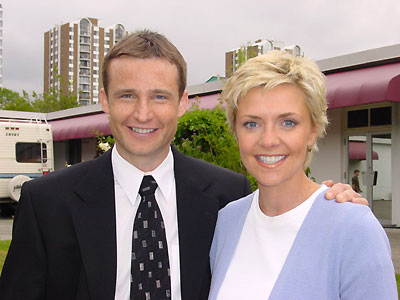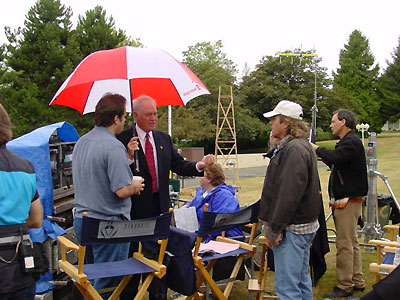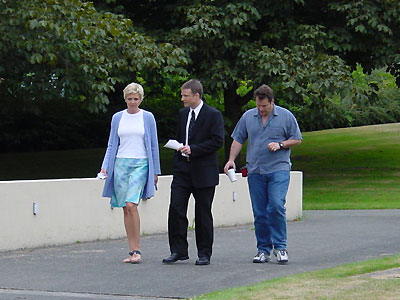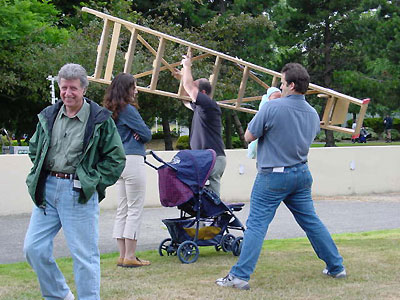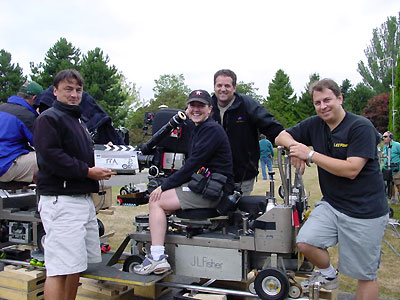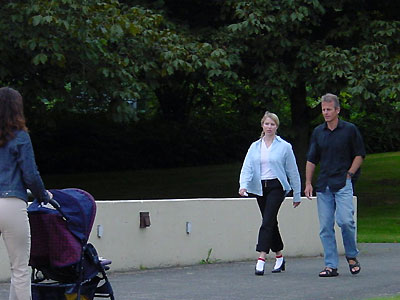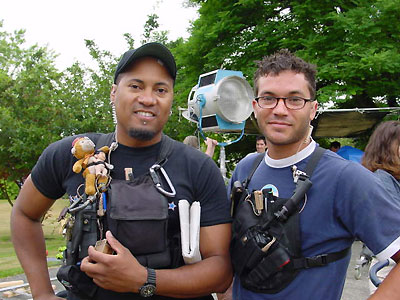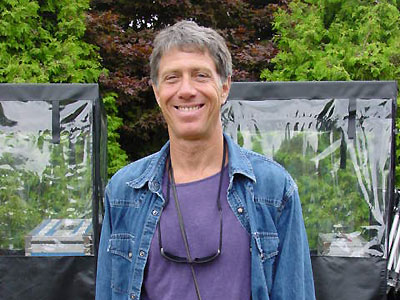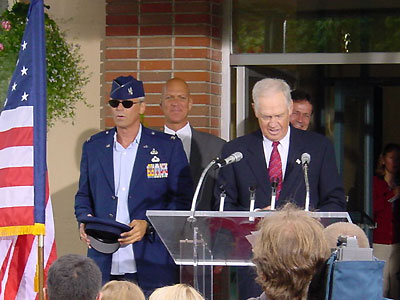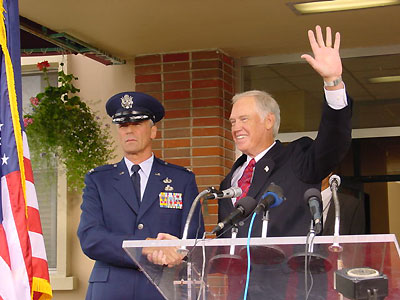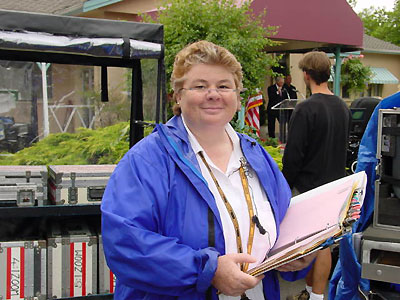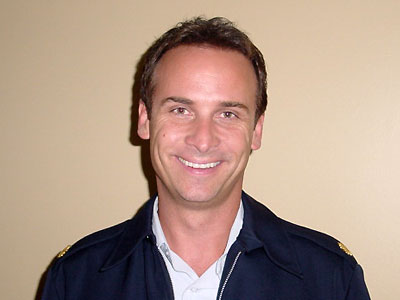ON THE SET - DAY THREE
Behind the Scenes of "Smoke & Mirrors": The Hospital
"Cloudy with sunny periods," the call sheet predicts optimistically. After a stretch of picture perfect weather, the morning of July 17th dawns threatening a chilly drizzle more typical of the Vancouver climate. It is the third day of shooting for the episode Smoke and Mirrors, and today the production will be entirely on location. The venue is the George Pearson Hospital, and early in the morning teamsters were busy moving the equipment in preparation. Trucks and trailers line 59th Avenue for blocks, and every parking space is filled as the production descends upon the quiet and secluded suburban neighborhood. The hospital, no longer in operation, is now a deserted building, and it provides the ideal location because its manicured grounds will also double as a park in Washington, DC.
The crew call is for 8am, and the park scenes are first on the schedule. Set Dec has provided a park bench in a corner of the property, and the equipment is put in place. A makeshift canvas roof is positioned over the bench as shelter from the mist and intermittent drizzle. Huge white reflectors are erected to direct the lighting. Dolly tracks are being laid to give the camera a sense of movement as the scene progresses. Off to the side, the video village monitors and the sound cart are also set up on rolling carts. To provide some protection from the weather, large red and white umbrellas are available everywhere for cast and crew, while cameras and equipment are adorned with towels and sheets of plastic.
The first scene is a straightforward one. Major Carter meets Agent Barrett on a park bench to discuss the circumstances surrounding Senator Kinsey's assassination. By the time the equipment has been set up, Amanda Tapping and Peter Flemming have finished with hair, make-up, and wardrobe, and have arrived on the set. Peter DeLuise blocks the scene with them, they run through a rehearsal, and then Hair and Make-up step in for final touch-ups before the scene is shot. It goes without a hitch, and promptly the equipment is arranged for the next scene in which Carter and Barrett continue their conversation while walking through the park. Amanda asks Peter if he needs to run lines with her before the next scene, but he feels it won't be necessary and thanks her all the same. They chat with some of the crew as they wait, and occasionally step inside the hospital building, away from the damp morning chill.
Peter Flemming and Amanda Tapping on the set of Smoke & Mirrors, and Ronny Cox confers with Peter DeLuise and Michael Greenburg
Meanwhile, Ronny Cox has arrived on set, in preparation for his scenes later in the morning. He approaches Peter DeLuise and Michael Greenburg with an important question. In one of the early scenes of the episode, a news report refers to Senator Kinsey as a likely choice for the "second spot" on the presidential ticket. However, in the scene to be shot later today, Kinsey has a line referring to his ambition for "the White House." The second spot on the presidential ticket, Ronny Cox points out to the producers, is not headed for the White House. Has it been established for certain if Kinsey is running for president or vice president? Should one of the lines be changed? It's a point of considerable discussion, and finally a phone call is put in to the studio for a definitive answer. The decision: regardless of the news report, Kinsey is not the type of politician who will settle for second seat. Ambition is in keeping with the character, and the White House line will remain.
Ronny Cox explains later, "I don't like that he's running for vice president, because that makes his speech at the end not mean as much. I'd rather that, even if he doesn't get the nomination, he's running for president. For him to say 'I'll be taking this with me to the White House,' he would have to defer to the president, because the president goes to the White House. He goes to the Blair House. He would have to be giving credit to the president, and I think that's not the sort of self aggrandizement that we want for this character. So at least in terms of this, we're having him run for president, not running for vice president." In fact, Kinsey has already been the president in the Aschen-altered version of the future. Whether he reaches that goal a second time has yet to be seen, but it's fairly certain that SG-1 has not seen the last of him. Just yesterday, he hints, Brad Wright had approached him about some fairly significant future appearances, and he couldn't be more delighted. When he first appeared in the episode "Politics," there was no indication that the role would be recurring, but he welcomes each opportunity to return. "This is about my sixth or seventh time to come up and do it," he smiles. Normally I don't do that many episodic television shows, but I'm delighted to come up here. First of all, these are such wonderful people, I mean, from the top down. And so any time they call me up, then I come in. And I'm having such fun now. I have such fun doing a diversity of things."
Diversity is indeed the word for Ronny Cox's career. "It's been a wonderful amalgam for me," he admits. "I started out playing nothing but good guys. For the first ten or fifteen years of my life I played Mr. Boy Scout nearly all the time. But then if you recall Total Recall and Robocop, they were the nastiest villains you can imagine. I mean, in Total Recall I was the dictator of Mars, the most ruthless guy you can imagine. Robocop as well. Kinsey is sort of ambiguous about whether he's good or bad. I love playing him because he's sort of wonderfully duplicitous." His many roles have involved a great deal of traveling over the years. Originally from New Mexico, he makes his home in Los Angeles now, although he is rarely there. "We're gypsies, you know," he explains, referring to the life of an actor. "This last year I've been doing a series, The Agency, in L.A., of course, but before that, I was working a lot. I went three solid years without working in L.A. I've done eight movies here in Vancouver. I feel like a gypsy. I'm hardly ever at home, although my wife goes with me everywhere I go."
A favorite aspect of his multifaceted career is his lifelong passion for music. In fact, it was his talent for music that gave him his first big break in films. "The reason I got Deliverance, which was my first film," he recalls, "was because I could play, because I played that dueling banjos thing for Deliverance. I've always played music. It's not a new thing. I'm a singer-songwriter. I do folk kind of music. And what I've found is there's a wonderful synergy between folk music and sci-fi people. I mean, there's a lot of sci-fi people and computer people who are also tied to that folk music genre too. I don't know exactly where that comes from. I don't quite understand what that is, but it's great. I just love the music, and being a singer-songwriter. And I'm trying to carve out a third of my year to play music."
Ronny has recently released his third CD entitled Cowboy Savant. "You've heard of idiot savant?" he laughs. At the time of the interview, the CD is brand new, but it has already met with promising success, and he has brought a copy of it to share with the crew of Stargate. He smiles, "This new CD is really new. It's less than a month old. I had originally intended just to sell it like I did my last album, just sort of over the internet and through my website, ronnycox.net. But luckily the response to it has been so good that I'm now sort of fielding offers from several record labels that want to do something about it. Actually, they're going to put my album on a link to the website so, we'll see."
He enjoys performing for live audiences as well, although a touring schedule is still only in its earliest embryonic stages. "There's a thing that music gives you that acting, no matter what kind of acting it is, doesn't give you," he explains. "No matter what kind of acting it is, whether it's movies, stage, plays, television, there is, and must be, an imaginary fourth wall between you and the audience. With music there can be a profound one-on-one sharing. And that's what I miss. That's the reason I love going and performing for people. I do a lot of that. I've actually now written a show where it's built around the music but I tell stories. Sometimes it's film stories, stories of the year, or stories of songs, or just stories of growing up. Or sometimes they're just lies," he laughs. "I'm a natural talker and a natural storyteller, and so I love doing that." He enjoys interacting with fans as well, but appreciates the intimacy of performing even more than appearances and conventions. "It interests me more that I can perform," he declares. "Rather than just going and signing autographs, and doing things like that, you feel like you can also give another part of you and share another part of you in a different way than you could before, which means a lot more to me. You know, you're not Senator Kinsey all the time, or Cohaagen, or Dick Jones, or whoever it is, you're not that person all the time. And I love to know, from the fans' point of view, that they're not just fans. They have lives, they do this, they do that. I'm more interested in that than in their being a fan. I love the thing that brings us all together, but then, that doesn't have to be our only connection we can have. So if I can show that there's more to me than just that character that they've met, I feel better about it. I know a lot of performers who just go and want to sign autographs. That doesn't work for me. I want more than that. If that sounds kind of Pollyanna-ish, I'll live with it, but that's sort of how I feel," he smiles, with a very un-Kinsey-like sincerity.
Peter DeLuise blocks out a scene with Amanda Tapping and Peter Flemming, and later he comforts the "baby" after a fall
As Ronny Cox returns for the final touches of make-up and wardrobe, preparations are in progress for scene 17, the walk in the park. First the scene must be blocked to determine exactly where the actors will be moving and where the cameras will be focusing. Amanda Tapping and Peter Flemming walk down the path of the park reciting their lines with Peter DeLuise close behind them, measuring the distance needed to cover the dialogue. After two or three tries, the ideal positions are established, and the starting and stopping points are marked on the path with colored tape. The scene calls for a number of extras as well. "Atmosphere A" includes a cyclist, a man with a dog and his Frisbee, an elderly couple, a woman with a dog on a leash, another woman with an infant in a baby stroller, and a handful of general "park folk." These players, too, must pace out their steps, timed to the dialogue, and Peter positions and directs each one. As he speaks to the woman with the infant, he reaches into the stroller and picks up the baby. Suddenly he exclaims, "Oh jeez!!" as the child falls to the ground. The startled crew turns to find, with relief, that it is a doll he has just dropped in his quest for a reaction from the crew. Nevertheless, he picks up the "baby" and comforts it at his shoulder as the rest of the crew chuckles and returns to work.
To give the scene a sense of movement, the cameras will pan as they follow the walking actors. This requires that a new set of dolly tracks be laid to guide the carts on which the cameras are mounted. This is the job of the grips, and they set to work building a small ramp from wooden blocks and metal rods. Stargate uses two cameras, designated Camera A and Camera B. Each camera is manned by a four person crew so meticulously coordinated that they function as a single person. The Camera Operator composes and frames the shot according to the instructions from the director, but also adds his own artistic expertise. Focusing the image, however, is the task of the 1st Assistant Camera Operator, or "Focus Puller." Occasionally with the help of a tape measure, but most often with simply a keen ability to estimate distance, the focus puller coordinates seamlessly with the camera operator to create a flawless image. In the case of Camera A, operator Will Waring and focus puller Jim Garrison have worked together for some time. The third member of their team, the 2nd Assistant Camera Operator, is Amie Gibbins. Asked to clarify her responsibilities, Will and Jim both grin, "She's the boss." Also referred to as the "Clapper Loader," it is Amie's job to set the clapboard, which records the episode, scene, take, and time code for each shot. These notes and numbers in turn are coordinated with the sound department and with the script supervisor so that every bit of footage will work together in editing. The fourth member of the team is actually part of the Grip Department rather than the Camera Department. Shawn Montgomery, the Dolly Grip, is responsible for pushing and guiding the wheeled camera into position for each shot. It is Shawn who is working with the rest of the grips to build the ramp for the camera tracks.
Although each position on the camera team requires a unique area of expertise, it is not uncommon for one position to advance to another. The clapper loader could become a focus puller, the focus puller often advances to camera operator, and the camera operator has been known to take on the role of director of photography or even full director. Will Waring has already tried his hand at directing an episode of Stargate, and through the luck of the draw, he found himself facing a challenge that would have been daunting to even a seasoned veteran. As a first time director, he tackled the highly emotional episode Meridian. With the luxury of hindsight, he looks back on the experience now and relates a few anecdotes with a smile. There was the scene, for example, in which Teal'c had bid an emotional farewell to a heavily bandaged and dying Daniel Jackson. Christopher Judge struggled with the emotions he was feeling toward his own friend Michael Shanks as he prepared to leave the series, and the anguish in his voice was genuine. Afterwards, Christopher was told that the man beneath those bandages was in fact Michael's stand-in, and that Michael himself had not even witnessed the touching farewell. Will Waring can't help but laugh as he recalls Christopher's indignation, thinking that he had "wasted" all that emotion on a stand-in. His directing debut was a positive experience in the end, and crew members hasten to add their words of praise for his talent and artistic eye. In fact, Will is slated to direct again in season six, the penultimate episode, Prophecy. Despite the fluid nature of the positions within a camera team, the bond within the unit is a powerful one, and has been known to extend from one series to another. When asked if the Camera A team will remain intact for another series when Stargate inevitably ends, Amie Gibbins answers without hesitation, "I hope so. I love these guys!"
Camera A includes Will Waring, Amie Gibbins, Jim Garrison, and Shawn Montgomery (left). Alaina and Bill Nikolai stand in for Amanda and Peter (right).
Once the dolly tracks and cameras have been put in place, and the lighting and sound equipment have been set up, the scene is rehearsed using stand-ins. Bill Nikolai, who usually takes the role of photo double for Richard Dean Anderson, or as Vern, the technician, today is standing in for Peter Flemming, and Alaina doubles for Amanda. Alaina, however, does not share Amanda's height, and so to add a few extra inches, she is wearing enormously high heels, paired with white anklet socks. "I love the socks!" Amanda calls to her. The doubles and the extras run through the scene, and then Hair, Make-up, Wardrobe, and Props swoop in for the final touches.
These departments have a number of responsibilities, not only in designing and creating the make-up styles, or the costumes, or the multitude of individual props that appear each week, but also in coordinating these features on the set during filming. The set presence for the Costume Department is in the person of Barry Peters, the Costume Set Supervisor, whose job it is to supervise the wardrobe on the set and to make certain that costumes remain consistent from one scene to the next. He wears a small pouch with sewing essentials as well as a camera and a collection of Polaroid snapshots to document specific scenes. The actor's sleeves were rolled up here, the shirt tails untucked there, medals were worn, shoes were missing, all of these notes are recorded, circled and highlighted on the snapshots in order to guarantee continuity. Similarly, Kenny Gibbs, the Assistant Prop Master, and his assistant Aaron Alexander, are responsible for providing and monitoring all props used in each shot. Viewers will recognize Kenny Gibbs from his small role as the Assistant Prop Master who shared his name on the production of Wormhole X-treme! On the set, he's easily identifiable by the myriad of props and toys he wears at all times, including a collection of Polaroid snapshots of his own, a few small stuffed animals and a tiny toy chest of the sort that plays a sound recording of a frantic voice demanding, "Excuse me! Let me out of here!" The Costume and Props departments coordinate very closely and often overlap. For example, jewelry falls under the domain of costuming, but watches and rings, specifically, are considered props. The frequently asked question about sunglasses, then, is addressed to both departments, and together they identify the style of sunglasses worn by Colonel O'Neill as "Bugaboos," which can be found in many sporting goods shops including Mountain Equipment Co-op on Broadway in Vancouver.
Military medals also transition from one department to another. Barry explains, "Originally, the military medals were props, because traditionally that's a prop thing. But on this show, because there was so much military with the Air Force stuff, the Costume Department agreed to take over the medal work. So if we have dress uniforms, we'll take care of all the medals. However, if a medal is being presented in a ceremony on camera, then it's Kenny's area. Kenny will come to me and go, 'What am I going to do?!' And I'll go, 'How about some magnets behind them?' And he'll go, 'You're brilliant! Thanks!'" The specific medals on each dress uniform are carefully researched and coordinated with the Air Force. Barry continues, "We are connected with the Air Force and they have a liaison person who comes, and they check all that stuff. Our assistant costume designer, Lid Hawkins, will call the Air Force and check all that stuff." Those fans who have studied the medals carefully have noticed the absence of pilot's wings for both O'Neill and Carter, although they have piloted various craft on the show. Perhaps they received civilian training and are qualified pilots without the Air Force status. The official explanation for the omission would be left to the Air Force, which has given direction to the Costume Department based on the suitable backgrounds in Special Ops or scientific research that these characters would have had.
It was at the request of the Air Force, too, that the new Air Force patch was added to the uniforms at the beginning of the sixth season. "The Air Force has just started using it," Barry goes on. "And they requested that we use it. It's the new Air Force logo that they're very proud of, and it just came out last year. So they asked if we could find a way of working it into the show. These uniforms, of course, are not real. They're created for SG-1 with the Air Force's blessing. But if they ask us to put something on them, we will do it. It went through a couple of different stages, because we have different colors. It didn't look right, so we changed them, and we came up with something that looks good on these uniforms. If you look at that first episode and then you look at the next episode, I think you'll see a change. We tried them on, and weren't happy, so we took them off until we got them fixed."
The Air Force was not the only logo to make a prominent appearance in early season six. In the episode Frozen, the entire crew was decked out in gear from North Face. What kind of a deal made that possible? "Oh, it's a good deal!" Barry grins, adding with a wink, "No, there was no product placement at all! You mean when we started on the North Face logo, like this, and then pulled back?" he laughs, indicating a zoom lens at close range. A few of those items came in handy as a temporary loan when one of the crew recently went on an Arctic expedition, but all the North Face gear, as with every other costume, is kept in storage. "It's all locked up in case we do another episode like that, or if we do re-shoots, or, say, in the sixth episode there was a reference to that and we have to re-shoot something. So we keep everything."
Likewise, the Props Department keeps every item in storage as well, and many of the props have been known to find their way into other episodes. For example, the ray gun that Martin picks up from the props table in Wormhole X-treme! was the same one that Togar aimed at SG-1 in the episode Urgo. Viewers with a keen eye might have spotted the virtual chairs from The Gamekeeper making a cameo appearance among the alien devices stored at Area 51 in the episode Point of View. The Goa'uld torture device has also made more than one appearance. The forked rod still has no official name, but is affectionately called the "cattle prod" by the crew and is a favorite Jaffa hand prop of Peter DeLuise. The in'tar training weapons first seen in Rules of Engagement have also been reused. When Jonas first joined SG-1, Brad Wright wanted him to have an aversion to killing, and he insisted that he use non-lethal weapons. For most of the early episodes he used a zat gun, and in Shadow Play he carried a 9mm handgun with the glowing red jewel of an in'tar at its base. As the season has progressed, his sidearm of choice varied somewhat, depending on the development of the character, or the cost effectiveness of the special effects required. The team weapons in general have undergone changes over the course of the series. SG-1 had always carried MP-5s on off-world missions, but during the fourth season the decision was made to use P-90s instead. The P-90 is armor-piercing, and more lethal against Jaffa. It is also a safer weapon for the actors to operate since it ejects downward and the casings are less likely to ricochet back into the actor's face. Peter DeLuise acknowledges that the MP-5 looks better on screen since "P-90s look like squirt guns." Although he adds, "You know what's a great visual? Rebel Jaffa with P-90s and Earth weapons. That is a great visual." Consequently, when Peter DeLuise is at the helm, the Earth weapon props are likely to show up in unexpected places, for example the rebel Jaffa army of K'tano carrying P-90s. It becomes a bit of a viewer scavenger hunt noting familiar props from one episode to another.
Assistant Prop Masters Kenny Gibbs and Aaron Alexander (left), and Costume Set Supervisor, Barry Peters (right)
Once scene 17 in the park is completed, the entire crew relocates to the hospital building for scene 49, the impromptu press conference with Senator Kinsey and Colonel O'Neill. This will be done as an exterior scene, shot at the entrance to the building, and so once again cameras, lights, sound, and equipment are moved and positioned. Ronny Cox awaits his call, chatting with some of the crew and extras, and Richard Dean Anderson makes his first appearance of the day. Having arrived on set earlier in the morning, he has completed his visit to Hair and Make-up, but Wardrobe is currently in a state of transition. The scene calls for O'Neill to be in his dress blues, but Richard, for the moment, prefers a more casual look, shirt tails out, sleeves rolled up, jacketless, tieless, hatless. He chats with the crew until the call to rehearsal, then slips his jacket on over the untucked shirt, and joins Ronny Cox at the podium before the members of the press.
The scene involves considerable dialogue for Ronny Cox, and he runs through it several times until he is satisfied that he is ready. Meanwhile, Richard occupies himself with wardrobe experimentation. First he slips on the hard brimmed dress combination hat. Then he adds sunglasses to the look. Next he reaches into his pocket and pulls out the soft fabric garrison cap as an alternative. He replaces the hat with the cap, wearing it first properly front-to-back, then mischievously turning it side-to-side with a huge grin. Through it all, Ronny Cox maintains his focus and perseveres with his lines, although the extras behind him, in the role of stern bodyguards, can't help but break into grins.
When the rehearsal is completed, the scene is set up for the cameras using stand-ins at the podium, while Barry Peters addresses the wardrobe issues for Richard Dean Anderson. Shirt, tie, jacket, hat are all adjusted, the Tibetan bracelet is tucked up under the sleeve, and Hair and Make-up add the final touches. At the podium, Bill Nikolai is standing in for O'Neill, while Finn Michael, often a second photo double for Richard, takes the place of Senator Kinsey. From the side, Richard tosses something to Bill, who promptly shoots it back, and a game of catch ensues as the cameras adjust their settings. Richard prides himself on the relaxed and playful atmosphere on the set and his self-described "manic behavior" that keeps the mood light. His latest prank is setting his cell phone ring tone to the theme of the Barnum and Bailey circus, then pulling it out between takes, a definite taboo on the set, and grinning impishly as it plays every last note, prompting the crew to roll their eyes and laugh in mock exasperation, "Can't you take him away??" When the cameras are ready to roll, however, he is the ultimate professional, and snaps back into character. As Richard and Ronny Cox return to the podium for the final take, it is Mother Nature who interferes. A number of crows have taken positions in the tree beside the building entrance, protesting loudly at the trespassers below. Several times the scene must be re-shot due to the raucous interruptions, and finally Richard Dean Anderson returns protests of his own with a very passable crow impression directed at the offending visitors. At last the scene is completed. The script calls for O'Neill and the senator to "shake hands vigorously." There is no mention of Kinsey's hand to the microphone, nor of O'Neill's hesitation in extending his own hand. Those were decisions of the actors and director, and Richard completes the handshake with a steely expression that gives no hint of the playful antics that went on only moments before.
Richard Dean Anderson experiments with wardrobe (left) in preparation for a scene with Jack O'Neill and Senator Kinsey (right)
This completes the exterior shots for the day, and the company now moves inside the building to begin the series of interior scenes. The first is scene 48, the meeting of Kinsey and O'Neill in the hospital room before the press conference. The deserted hospital room has been completely decorated by the Art and Set Dec departments, from medical equipment to the signs in the hallways. The room is small, so most of the crew waits in the hallway as the scene is rehearsed and prepped. The scene is a fairly uncomplicated one, but the sound department points out that Senator Kinsey's shoes are squeaking as he walks across the room. Richard Dean Anderson waits in the hall for his cue to enter the room, and each time the scene begins, the distracting sound remains, and the scene must be redone. As Richard waits in the hallway again, the discussion in the room addresses possible solutions. Perhaps Ronny Cox could take off his shoes and do the scene in his stocking feet. His feet would not be visible on camera, but Ronny points out that the difference in height of the actors might be noticeable, explaining, "He's taller than me." From the hallway comes the bellowing voice of Richard Dean Anderson, "Taller than I!" "You knew that was coming," responds a voice from inside the room, well familiar with Richard's reputation for correcting grammar.
When at last the problem of the squeaking shoes is corrected, the scene is completed, and the crew breaks for lunch. There is ice cream on the menu for dessert, and the teamsters have been sent on a special run to deliver it to the location. Picnic tables are set up on the grounds, and a huge tent is set up over most of them to offer some protection from the chilly drizzle that has returned after a temporary respite. Richard Dean Anderson has completed his scenes for the day. After lunch he'll spend the afternoon concentrating on his executive producing responsibilities, including a long session of editing in his trailer with Michael Greenburg and his assistant Ivon Bartok. The scenes scheduled for the afternoon are the remainder of the hospital interiors, and since several of them call for morphing effects from the Visual Effects Department, James Tichenor has arrived on set to supervise.
After lunch, the action moves to a large open room within the hospital. Perhaps once used as a recreation or dining area, it is now designated a "holding area" for about a half dozen extras. Assorted doctors, orderlies, nurses, and patients wait to be called for their moment to walk down the hallway as "Atmosphere D." Peter DeLuise and the Assistant Directors choreograph the scene, keeping in touch by walkie talkie. Traditionally there are three assistant directors, but Stargate makes use of a few more than that. For this episode, the 1st Assistant Director is Alex Pappas. He is the eyes, ears, and voice of the director, making sure that the director's orders are carried out, and coordinating the action on the set. It is also the responsibility of the 1st AD to prepare the "Oneline" schedule for each episode, a sort of summary of the locations to be used and the scenes to be shot each day. The 2nd AD shares some of these responsibilities on the set, and also prepares the daily call sheet which lists exactly which scenes will be shot, and which cast members will be needed for each. Page numbers, call times, and any necessary props, costumes, or effects are all listed in detail. Stargate uses a pair of 2nd ADs, Dwayne Launt and Janice Genn. The 3rd AD, Gisela Schulte, prepares the production report each day, and is the one who calls for the actors and makes sure each person is where he needs to be. An additional trainee AD can also assist the 1st AD, signal the background and extras, and coordinate with the walkie talkie. Together, the team keeps the production moving smoothly by keeping track of everything that happens and everything that is needed. Usually the 1st ADs, Alex Pappas and Bill Mizel, tend to alternate episodes, sometimes partnering with a director. The other ADs, however, work the complete cycle of every episode, and they have some interesting stories to tell, always with a smile, of behind the scenes mishaps, emergencies and antics.
As the equipment is being set up in the big dimly lit room that will double as the basement of the hospital, there is a relaxed lull that is being filled by music. The sound cart has a copy of Ronny Cox's new CD, and they are playing it through the sound equipment. Although it does not broadcast through speakers, it can be heard by everyone wearing a headset, from the director to the ADs and the script supervisor.
Candice Field, the Script Supervisor, offers to share the music as she updates some of her notes. The job of script supervisor has so many aspects it is not easily described. Basically, she says, "I'm a paid people watcher." Seated by the monitors of the video village, a headset in her ear, a stopwatch in her hand, and a bound copy of the script on her lap in which she keeps meticulous notes, she monitors and records nearly every action and movement of a scene. It is her responsibility to make sure that an actor duplicates his actions exactly each time that a scene is shot, so that the pieces will fit together seamlessly in editing. "I help the actors with when they make their moves, on what dialogue," she explains. "If they take a walk across the room on a certain line, I remind them that that's where they did it so they can be consistent." An actor's movements, gestures, manipulation of props, all must happen at exactly the same time and in exactly the same way each time the scene is shot. Candice keeps copious notes so that a scene can be duplicated, but the actor, too, must share the responsibility for planning how he will approach the scene, and then he must remain consistent. "The actor also has to take responsibility," she continues, "for deciding what he's going to do with a prop. You can track everything meticulously, but if the actor doesn't decide what he's going to do when and where, he'll never be able to repeat it. He has to decide what he's going to do, if he'll start with a half-eaten sandwich, and then take three bites and deliver his lines, and then do it. If he's not aware of what he's doing, he won't be able to repeat it, no matter how many times I tell him what it is." Richard Dean Anderson is notorious for taking advantage of props on the set, for adding gestures or manipulating props in an almost impulsive manner. Is he a special challenge to track? Candice answers with a smile, "That's acting! But no, he tends to work out what he's going to do and when, and then he'll pick something to do. He does it very thoughtfully, so he is able to repeat himself. It's a joint effort. I help him with it. But he can repeat it, because he's thought it through. For the most part!" she adds with a laugh. "If I see that he's not thinking about what he's doing, I remind him that there will be other camera angles that he'll have to match it to, and then he decides what he wants to do then."
How does one person keep track of so many actors at once? "It's difficult when there are a lot of people in a scene," she acknowledges. "That's why you need them to take a certain responsibility for themselves as well, because you can only watch one person at a time. So I just look around, and I make a map as to where everyone is, where the camera's set up, so that I know all the different angles, and I know the screen directions off the master, so the shots will all connect with each other. I'm here as sort of a safety net. If we do get a little off track then we can bring them back and get them looking in the correct direction." The camera operator also makes a mental note of the movements as he works, so together they keep the scenes consistent. "When it's really really complicated, with a lot of important things to see, I often assign different people tasks. Like, tell me when this happens, tell me exactly the moment that this happens in the dialogue. They're assigned to watch, and tell me if he does this or that. If I'm roaming or looking at everybody, I miss things, and I know that certain things you can't miss. It's a lot like doing a puzzle, and making sure all the pieces will fit later."
Multi-tasking is also an important prerequisite of the job. In addition to monitoring the movements of several people at once, Candice also keeps track of the dialogue. Her earpiece, linked to the sound cart, lets her hear all the dialogue clearly. "It's important that I make sure that they don't fluff their lines, or miss lines. So I know exactly what they're saying." If an actor forgets a line, she feeds the line from the script, and often in scenes that call for one-sided dialogue, for example a conversation by telephone or radio, Candice provides the other half of the conversation for the actor to respond to. She supports the camera team as well by recording the technical information from the camera assistants that may be used later by a director or editor or visual effects artist to enhance or reproduce a scene. "Camera assistants give me technical information for the record. I keep it as a courtesy. This is a very minor portion of the job. In the States, actually, the camera assistants keep this information themselves, but up here they pass it off to us."
It is a challenge being a single-person department in such a specialized field. Although there are courses nowadays to train for the necessary skills, when Candice began, she trained as an apprentice, working with film students and gradually moving to bigger projects. "You just have to jump in and do it, and get your feet wet on small projects," she smiles. She has been doing it a long time, and still enjoys the challenge of the work, and especially the caliber of the people she works with. Like Jan Newman and Dan Shea and Bill Mizel, and many others on the Stargate set, Candice is a veteran of MacGyver, and she's delighted to still be working in such a familial environment.
Script Supervisor Candice Field (left) and Colin Cunningham as Major Davis (right)
Scene 46 marks the first appearance of the day for Major Davis, and Colin Cunningham has arrived on the set. He has truly enjoyed the evolution of his character from a small appearance in second season's A Matter of Time to status as a recurring guest. Originally he had no idea that Major Davis would return. "In fact," he recalls, "I'd auditioned for the show, it feels like at least twenty times, and I could not get arrested! I mean, I auditioned for the pilot. I had originally auditioned for Daniel Jackson way way way back when. There's a lot of recurring characters, a lot of times they ask people back, but I had no intention or expectation whatsoever of being invited back. I just remember thinking I'm going to go in there, I'm going to do the best job that I can, and that'll be that, you know? And I was actually surprised to get called back, and each time, in fact even to this day, I'm always surprised when I'm called back. It's awesome, you know, I get to go back to Stargate. But I can't believe I've done as many as I have over as many years that I've been a part of it all. So it's been wonderful, it really has. I definitely have to thank Michael Greenburg and Brad and John and all those guys. I mean, they're the ones that are behind it." His multiple appearances have given him the opportunity to create a character with depth beyond the typical military stereotype. "I remember the first day, on that first episode, I thought, I don't want to play another file-carrying Pentagon official that's the hard-ass and the pain in the ass and not sympathetic. So I thought, I'm going to try and do it a little bit differently, maybe a guy that's got a job to do, but is more sympathetic to what's actually happening on the floor, so to speak. I try to interject a little bit of a human element instead of being so cold, and by the book and stuff. At least that way I could, maybe, bring a little bit more depth to the character, I suppose."
Most recently he had completed Prometheus, an episode he is especially excited about. "The last one I did, Prometheus, that's probably the biggest Major Davis episode thus far. And it was fantastic. I mean, it was really great to be given more, not only more in terms of what I'm doing but also just in terms of importance. I'm not so much a facilitator in that particular episode, of things or dialogue or information, but instead, I've got responsibilities and I'm under a lot of pressure. You get to see a little bit more of what Major Davis does when he actually is assigned to something very specific. The stakes were a little higher with Major Davis in that particular episode, which I really enjoyed doing." He has yet to venture through the stargate on camera, however, and it is something he still hopes to have the chance to do. "I've always wanted a moment with Major Davis standing there looking at the gate like a dream come true, he's finally going through the gate. And that's yet to happen, so we'll see what happens."
He is also looking forward to meeting with fans at upcoming conventions he has scheduled over the next few months. "I've been really surprised, in terms of the, for lack of a better word, popularity, or the fact that people have even remembered Major Davis or tuned in for Major Davis. It's really neat. The first convention I went to was in Australia, and I was amazed at how many people were familiar with the character, and all that kind of stuff. It was like, wow! This is wonderful! For the first time, I think I felt like I was a part of something, whereas before I just felt like I was a day player/actor that they bring in every now and again whenever they needed somebody. To get the odd fan letter and stuff like that, it's really nice."
Once the equipment is in place, Colin is called to rehearsal. Scene 46 is a complicated one. Carter and Barrett encounter Major Davis in the hospital basement, and when Carter zats him, he morphs into another character named Devlin. It is the morphing effect for which James Tichenor, the Visual Effects Producer, has been called to the set. A camera is directed at the mat on the floor where the effect will occur, and the image appears on a pair of computer monitors. From here, Tichenor can manipulate and match the image. The scene is shot several times to make sure that the actors hit their marks exactly. Carter fires her weapon, and a startled Major Davis falls to the floor where a mat breaks his fall. For the next shot, the mat is removed, and Carter approaches the unconscious Davis and removes the alien mimic device which causes his appearance to change. Tichenor's monitor records an image of Colin Cunningham's exact position on the floor. Then Colin walks away, and Jon Cuthbert, the actor playing Agent Devlin, takes his place on the floor. Using the computer image almost as a template, James Tichenor calls directions to Cuthbert, telling him exactly how to place his body. "Move your head a little to the left! Move your right arm up a little higher! Move your left leg two inches to the right!" With each direction, the image of Devlin aligns itself exactly to the image of Davis.
Finally, Tichenor is satisfied that the two images will match enough to complete the morphing effect using computerized visual effects in post production. "Don't move! Don't BREATHE!" Peter DeLuise commands, and the last part of the scene is re-shot with Devlin in place of Davis. "Action!" calls DeLuise. Carter approaches the unconscious body and removes the device. No one moves. The set is silent. Amanda hesitates, awaiting word from the director who is standing over the motionless man on the floor. After a long thoughtful pause, DeLuise draws a deep breath, and then, blowing through his lips, he emits a long drawn out sound that can only be described as passing gas. That does it. The silent crew begins to chuckle, and the unconscious Devlin can't help himself. He begins to laugh, and immediately DeLuise pounces. "Didn't I tell you?! DO NOT MOVE!!" he bellows, then, having achieved his objective, he flashes a huge grin. "Cut!" he yells.
The humor keeps the long working hours bearable. It is early afternoon now, and six more scenes have yet to be filmed. Tomorrow is another long day with an early call. For the next two days, the rest of the interiors at the Air Force base holding cell, the NID headquarters, the warehouse, and Carter's hotel room will all be shot on location at the Zephyr Building. The building is located on Boundary Road, across the street from the studio. Nevertheless, as with all location shoots, tomorrow's call sheet includes a detailed map with directions for the cast and crew, and the capitalized admonition across the bottom:
RIGHT ACROSS THE STREET FROM THE BRIDGE STUDIOS!!!!
***SO DON'T GET LOST***
Apparently it is easier to navigate across galaxies.
____________________
Ritter, Kate. "On the Set - Day Three." July 17, 2002.

